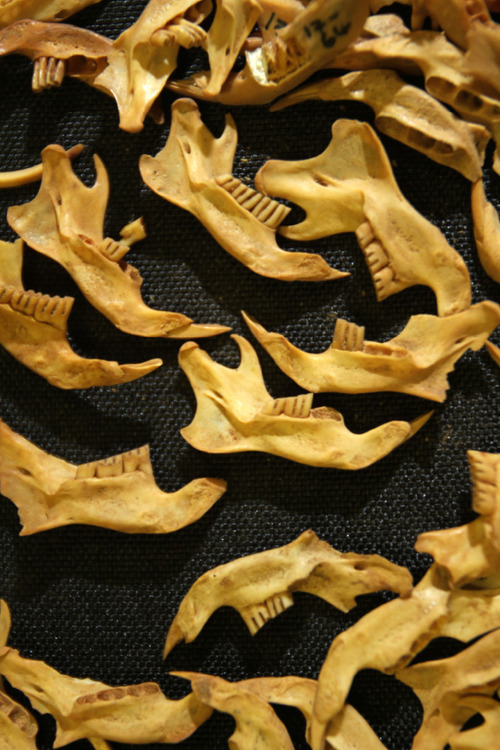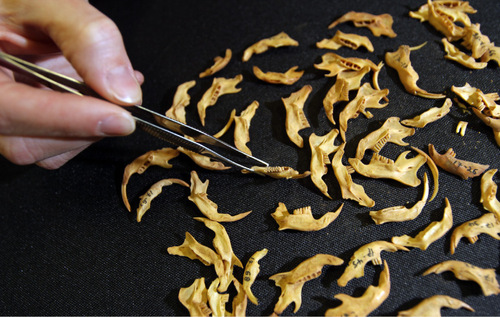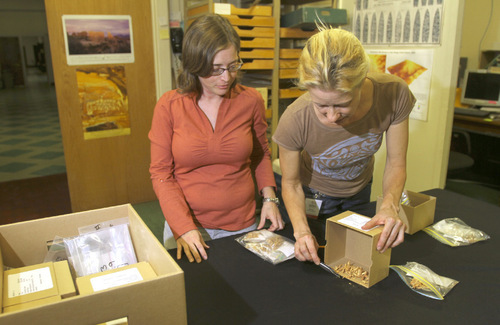This is an archived article that was published on sltrib.com in 2010, and information in the article may be outdated. It is provided only for personal research purposes and may not be reprinted.
Homestead Cave is not much to look at, a modest opening in a knoll at the north end of Utah's Lakeside Mountains. But it has yielded a paleontological jackpot for scientists reconstructing ancient Great Basin environments thanks to owls that spit up small-animal prey in the cave for thousands of years.
The piles of regurgitated pellets drew Dave Madsen in the early 1990s to this lonely spot on the Utah Test and Training Range west of the Great Salt Lake. Then with the Utah Geological Survey, Madsen and colleagues Don Grayson and Jack Broughton hoped the bones, known as "death assemblages," would provide a record of the plants and animals that inhabited the surrounding area over the years.
What they found was scientific pay dirt that continues to yield dividends. Three years of excavation recovered undisturbed bones layered down at least 2 meters, representing what's been on the owls' menu for the past 13,000 years.
—
Museums and the process of science • Young researchers like Rebecca Terry have returned to the resulting collection — millions of tiny orange-brown bones and dirt at the Utah Museum of Natural History — to study how the local ecology responded to past climate change.
"It's an amazing record. It's still giving us so much information and the whole strata have not been studied yet," said Terry, now a post-doctoral research fellow at Stanford University.
Terry's research will be illustrated in an exhibit about Homestead Cave at the museum's new building, scheduled to open next year in Research Park. Housed in the Lands gallery, it features a core sample from the cave's floor, encased in an acrylic tube with a sliding magnifying glass.
"We're trying to engage people in the process of science to understand how it works," said Becky Menlove, the museum's exhibits manager. "It's all about observation, analysis and comparison. Rather than recreate the cave, we're telling the story that the cave sediments tell."
Salt Lake County voters on Tuesday will decide on a proposed $15 million bond to finish the museum project, mostly to complete exhibits and collection space for its 1.2 million-item holdings. The Homestead collection illustrates a crucial function of public museums that remains largely invisible to the public. To be useful to science, UMNH has to safeguard and organize collections and make them available to researchers, officials say.
The museum keeps the Homestead bones in hundreds of plastic bags organized in dozens of boxes. Much of the material, such as the lizard and bird bones and pollens, has yet to be analyzed.
"This is like a library for people like Rebecca [Terry] and me," said museum postdoctoral fellow Rebecca Rowe while handling a bag containing mandible parts from wood rats.
—
A pristine biological record • Homestead Cave was an ideal place to preserve such a record because its interior has a constant cool temperature protected from the sun, wind and rain and was never the site of a prehistoric human habitation, said Rowe, an evolutionary biologist. Its location on a military reservation has preserved it from modern humans.
Its west-facing opening is about 25 feet across and its cavern tapers back 50 to 60 feet.
"It's not that big a cave, it's like a garage," said Madsen, now an adjunct research professor at the Texas Archeological Research Laboratory in Austin.
Madsen's crew dug for three field seasons before hitting the bottom of the cave as they meticulously isolated a 1-meter-square column of bones, then bagged each of about 20 layers for analysis and radiocarbon dating. Because owls often swallow their prey whole, many bones, even complete skulls, were intact when they were regurgitated in pellets of hair and other non-digestible material.
Grayson examined 186,000 tiny bones, identifying which of 22 species of small mammal they came from.
"I spent five years in the lab. I'll never do it again," said Grayson, an anthropologist and curator at University of Washington's Burke Museum of Natural History and Culture.
Grayson dated the layers, so that for each time period he documented changes in each species' relative abundance. Then a University of Chicago graduate student, Terry ran with Grayson's findings, winning the prestigious Romer Prize from the Society of Vertebrate Paleontology.
—
Linking bones to ancient climates • Terry's research demonstrated that Homestead's ancient compendium of bones accurately reflects the small-mammal communities that inhabited the Great Basin.
She trapped small animals around the cave with Rowe's help, then compared what they caught with what the Homestead owls had spit up.
"You can sweep up the cave in an afternoon and have a record of what animals were there as if you had trapping records," Terry said.
Owls are night hunters that roost during the day, but their diet wasn't limited to nocturnal creatures, she found, because diurnal animals are active at dawn and dusk, like the owls.
Terry later charted how the relative abundance of the various mammals — pack rats, mice, voles, rabbits, shrews — fluctuated in close association with climate changes documented in another paleo-ecological record. Core samples taken from a nearby lake revealed average July temperatures, she said. Other researchers had reconstructed the local climate by determining which species of chironomid, a diverse family of aquatic midge commonly known as muffleheads, appear in dated lake layers going back thousands of years.
Terry discovered that when temperatures tended warm, southern-leaning rodent species predominated, but their northern cousins were in greater abundance when temperatures were colder.
These findings, Terry said, can help biologists predict how rapid warming expected in the coming decades will affect Great Basin animal communities and develop appropriate conservation strategies.
Homestead Cave preserving bones
This remote cave west of the Great Salt Lake has yielded a well-preserved paleo-ecological record in the form of layers of ancient owl pellets and the tiny bones they contain. A future exhibit at the Utah Museum of Natural History, where millions of these bones are stored, will show how scientists use this material to document animal communities dating back 13,000 years and how those communities responded to climate change.











